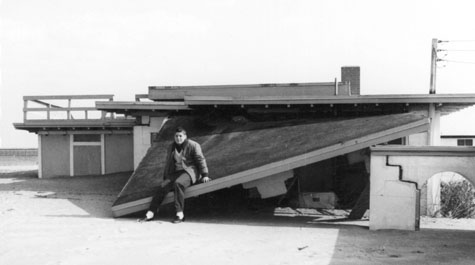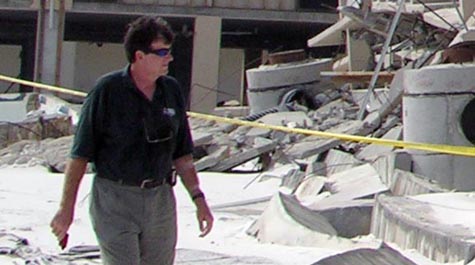Alumnus carves a career studying the coastal impacts of extreme storms
Editor's note: We were in the process of developing this alumni feature on Abby Sallenger (Ph.D. ’75) when he unexpectedly passed away at his home in Florida on February 5, 2013 at the age of 63. We’ve decided to publish the feature posthumously to honor Abby’s long career and recognize his many accomplishments. It’s particularly fitting that this story appears on Feb. 13, Ash Wednesday, in light of the impact the Ash Wednesday Storm of 1962 had on Abby’s career.
The Ash Wednesday Storm of 1962 was one of the most destructive storms the mid-Atlantic states have ever known. Over the span of three days—and five high tides—the massive nor’easter raged up the East Coast, ultimately capturing the attention of a young boy named Abby.
Thirteen years later, Asbury (Abby) Sallenger Jr. received his Ph.D. in marine science at the Virginia Institute of Marine Science, formalizing his life-long interest in beaches and the coastal hazards that threaten them. Currently serving as a research oceanographer for the U.S. Geological Survey’s Center for Coastal and Watershed Studies in St. Petersburg, Florida, Sallenger has become a world-renowned scientist and expert on coastal hazards.
“I was 13 years old when my father took me down to the Outer Banks to survey the damage after the storm of ’62, and I witnessed first-hand how the storm surge had pushed prominent dunes into oceanfront homes,” says Sallenger. “I sat on the roof of one of the houses with my feet resting on the sand and from that moment on I have been hooked on studying the effects storms can have on beaches.”
A native of Virginia, Sallenger grew up spending weeks on-end at his family’s beach cottage along the Outer Banks of North Carolina. A graduate of the University of Virginia, Sallenger bypassed his Master’s degree before coming to VIMS to study the origin of crescent-shaped shoreline features—known as beach cusps—that appear rhythmically along beaches.
Since graduating from VIMS more than 35 years ago, Sallenger has carved a career out of studying the impacts of extreme storms on coastlines and surveying beaches that have been damaged by coastal erosion and sea-level rise. Sallenger has served as the voice of the USGS on hurricanes and coastal change since the mid-1990’s.
In 2009, Sallenger’s passion for storms and rising seas led him to write Island in a Storm, a novel depicting a mid-19th century hurricane that ravaged Isle Derniere off the coast of Louisiana. Based on true events, his story presents a cautionary environmental tale of a warming world and rising seas. The book, published by PublicAffairs™, was chosen by the American Library Association as an outstanding academic title for 2010.
“I wanted to incorporate science into my writing because I found it fascinating to explain the technical research I do to a non-technical audience in the form of a story,” says Sallenger.
Sallenger recently served as project lead for a USGS research group exploring the regional variability of sea level rise. Their report—published this past June in Nature Climate Change— is titled “Hotspot of accelerated sea-level rise on the Atlantic coast of North America”. It reveals that rates of sea level rise are increasing 3-to-4 times faster than the global average in a “hotspot” stretching from Cape Hatteras, N.C. to Cape Cod.
Having spent so much time on the Outer Banks—and with the memories of the Ash Wednesday storm indelibly imprinted in his memory—Sallenger developed a geographical classification system to help researchers gauge storm hazards on barrier islands while heading up the USGS’s National Assessment of Coastal Change Hazard project.
A pioneer in protecting coastal communities from the hazards of coastal change, Sallenger says his biggest accomplishment has been developing the program on coastal and marine geology for the USGS. “Getting to spend the time creating the program with my colleagues and building it into something substantial that has persisted over time has been the highlight of my career,” he says.
From being a student at VIMS to a respected geologist, Sallenger says his true passion in life has always been research. “I love developing hypotheses and coming up with rational tests,” he says. “That’s my idea of a party!”
While pursuing his doctorate, Sallenger says his favorite pastime was to sit in the library at VIMS, thumbing through journals and reading the papers of other researchers. “I was fascinated by the fact that studying beaches was something that people made an entire career out of,” he says. “I love coming up with my own hypotheses on how sea-level rise varies around the world and why it is happening and testing my own hypotheses. It’s the discovery that fascinates me.”
Reflecting on his experiences at VIMS, Sallenger remembers the camaraderie he had with fellow students, some of whom he is still in touch with today. Fellow classmate and VIMS alumnus Carl “Woody” Hobbs says Sallenger “always had a good sense of humor and a caring attitude for his fellow students, while always working hard and staying focused, and those are characteristics he has exemplified through his entire career.”
“I fondly remember discovering a whole world of fascinating research on understanding beaches while I was at VIMS,” says Sallenger. “It was enthralling for me to figure out ways that I could possibly contribute to that world.”
After years of groundbreaking research and discoveries, it is safe to say that Sallenger’s goal to contribute to the world of understanding beaches has not only been accomplished—but exceeded.
 Skip to main content
Skip to main content


